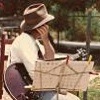Home » Jazz Articles » Live Review » Henry Butler: San Diego, April 12, 2011
Henry Butler: San Diego, April 12, 2011
 Henry Butler
Henry ButlerSaville Theatre, San Diego City College
San Diego, CA
April 12, 2011
The path that brought famed New Orleans pianist Henry Butler to the Saville Theatre on April 12 has been rich in diversity and inexorably directed to his core : the wide scope of Crescent City music, and the deep well of the blues.
Although he began his professional career in jazz as a thoroughly modern keyboard stylist—Fivin' Around (Impulse! 1986), an adventurous session featuring Charlie Haden on bass and Billy Higgins on the drums, followed by The Village, (Impulse!, 1987), with Ron Carter and Jack DeJohnette, positing his own take on post-McCoy Tyner realities—since 1990 he has returned to a more Louisianan examination of the blues in all its iterations.
Blind since birth, he was led to the piano resplendent in a bright orange plaid suit, and once situated, began the music with a piece by fellow-New Orleans master Alvin Batiste called "Mozart." The melody borrowed a few recognizably Baroque phrases by the famed composer and stretched them gradually into something entirely different , but in the space of 90 seconds, the baroque became the barrelhouse.
He announced Scott Joplin's "the Entertainer" with the caveat, "It's not considered proper to improvise on a ragtime piece," but having said that, tore through the well-known tune, improvising at will, and taking it 12 steps further than Joplin himself could have imagined. His right hand spun manic high speed runs that double- and triple-timed the already furious tempo, which his left foot stomped out relentlessly like a pile-driving metronome.
Next was an intriguingly modern glance at the blues form, an original called "The Break," that Butler revealed was written after hanging out with pianist George Duke. He laid down a very busy left-handed ostinato offset by rolling chords voiced in fourths, an extrapolation that had the effect of disguising its blues form in the same way that many of Herbie Hancock's Blue Note recordings of the 1960s excelled at doing this.
Next he borrowed another tune from his frequent collaborator Batiste, "North American Idiosyncrasies," a slow, surging blues with a riff-style head. The pianist has got an intriguing take on the right-left hand relationship that was highlighted on this piece. He began with the standard demarcation, left hand pounding solid bass lines with the right involved in bluesy trilling—halfway through the piece, however, he moved both hands toward the middle register and started a series of octave-doubled runs remarkable in their clarity and alacrity.
Dedicating the next tune to New Orleans legend Professor Longhair, Butler opened "Orleans Inspiration" with an infectious, rollicking bass vamp that inspired an audience "clap-along" on the downbeats. Butler used the rhythm as a springboard for wild, rococo flourishes that expanded the vernacular in a multi-dimensional fashion.
After all of this manic, blues-based virtuosity, he brought down the house with a supremely sublime take on the standard ballad "That's All." He transfigured the acoustically pristine Saville Theatre and the grand piano into one gorgeous instrument on this piece—engraving each note of the melody with meaning, while his left hand gently rolled out the lingering harmonic structure.
Butler is also a vocalist of distinction, and he showcased this side of his musical personality with a furiously funky reading of "Let It Roll," a blues in G that traveled through many moods and styles, while rocking with sufficient urgency to induce another round of crowd-supplied downbeat clapping.
The pianist wrapped up the ebullient proceedings with another spirited vocal on, "Mardi Gras In New Orleans" from his 1990 disc on the Windham Hill imprint. The capacity crowd roared in approval.
Photo Credit:
Tom Westerlin
Comments
Tags
Henry Butler
Live Reviews
Robert Bush
United States
Charlie Haden
Billy Higgins
Ron Carter
Jack DeJohnette
McCoy Tyner
Alvin Batiste
Scott Joplin
George Duke
Herbie Hancock
Professor Longhair
For the Love of Jazz
 All About Jazz has been a pillar of jazz since 1995, championing it as an art form and, more importantly, supporting the musicians who create it. Our enduring commitment has made "AAJ" one of the most culturally important websites of its kind, read by hundreds of thousands of fans, musicians and industry figures every month.
All About Jazz has been a pillar of jazz since 1995, championing it as an art form and, more importantly, supporting the musicians who create it. Our enduring commitment has made "AAJ" one of the most culturally important websites of its kind, read by hundreds of thousands of fans, musicians and industry figures every month.























